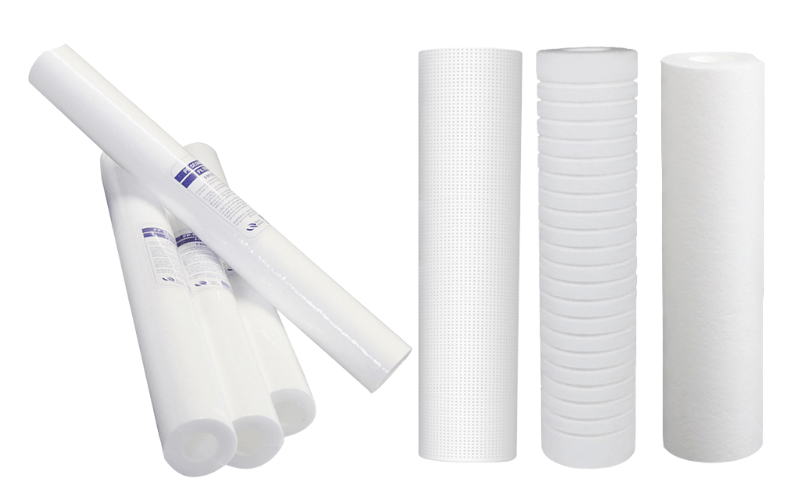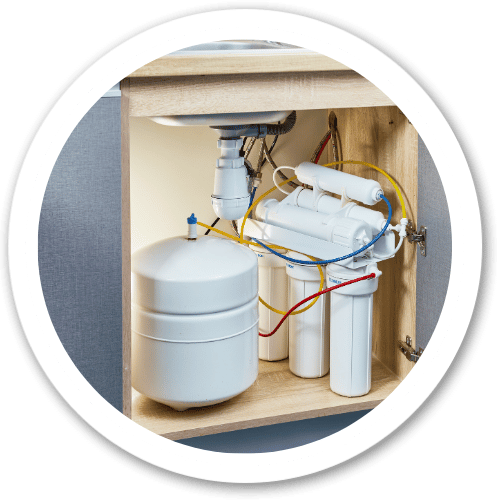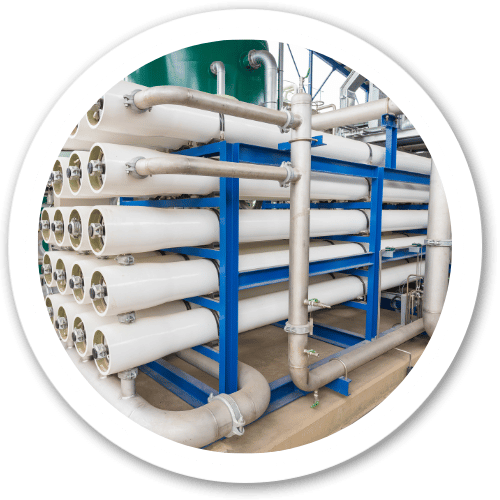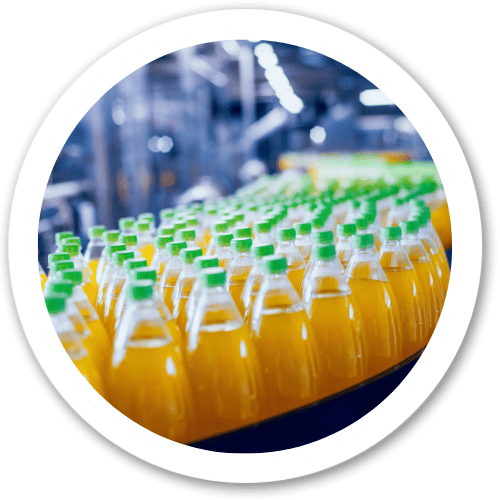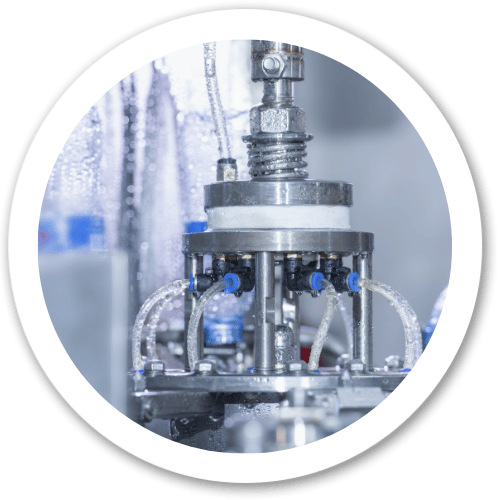Melt-blown filter cartridges are a crucial component in modern liquid and gas filtration systems, providing high efficiency and versatility across various industries. While they may go unnoticed by the average consumer, these filters play a vital role in ensuring clean water, sterile medical environments, and contaminant-free industrial processes.
If you’ve ever used a water filter, medical device, or even an air purifier, chances are a melt-blown cartridge was working behind the scenes to remove impurities. But what exactly makes these filters unique, and why are they preferred in so many applications?
Let’s dive into the fundamentals of melt-blown filter cartridges, including their manufacturing process and the key industries that rely on their precision filtration capabilities.
Table of Contents
ToggleUnderstanding Melt-Blown Filter Cartridges
The Melt-Blown Process: A Simplified Explanation
The melt-blown process is a specialized manufacturing technique used to create fine, nonwoven fibers from thermoplastic materials. In this process, polymers are melted and extruded through tiny nozzles while being simultaneously subjected to high-velocity hot air. This results in the formation of ultra-fine fibers that are randomly layered to create a porous structure. The resulting material is then shaped into cylindrical cartridges, which are widely used in filtration systems. This method ensures a consistent fiber distribution, making the filters highly effective at capturing particles of varying sizes.
Primary Materials Used in Melt-Blown Filters
One of the most commonly used materials in the production of these filters is polypropylene, a thermoplastic polymer known for its durability, chemical resistance, and cost-effectiveness. Polypropylene is ideal for filtration applications due to its non-toxicity, lightweight nature, and ability to withstand a wide range of temperatures and chemical exposures. Other materials, such as polyester or nylon, may also be used in specific applications, but polypropylene remains the industry standard due to its versatility and performance.
Distinctive Features of Melt-Blown Cartridges
Melt-blown filter cartridges are renowned for their unique structural and functional characteristics. One standout feature is their graded density design, where the outer layers are less dense to capture larger particles, while the inner layers are more compact to trap finer contaminants. This gradient structure not only enhances filtration efficiency but also maximizes the cartridge’s dirt-holding capacity, allowing it to operate longer before requiring replacement. Additionally, these filters are free of adhesives or binders, ensuring chemical compatibility and reducing the risk of leaching. Their ability to handle high flow rates and maintain consistent performance makes them a preferred choice for industries requiring reliable filtration solutions.
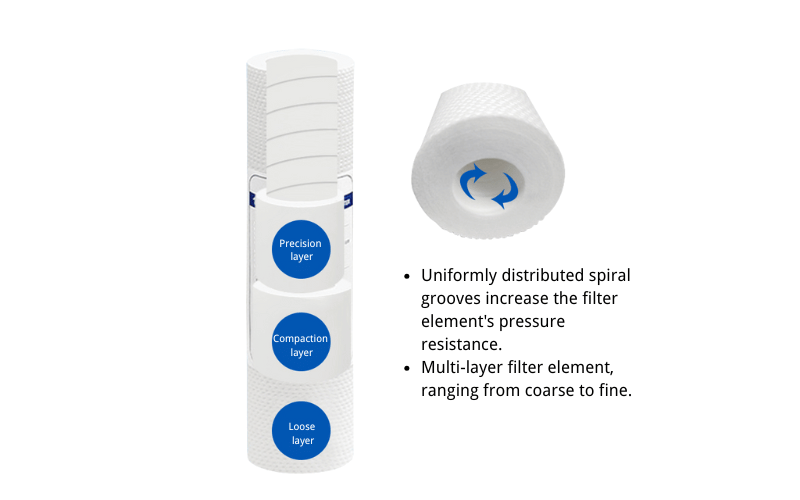
How Melt-Blown Filter Cartridges Function?
Step-by-Step Filtration Process
Melt-blown filter cartridges operate through a straightforward yet highly effective filtration mechanism. As fluid passes through the cartridge, contaminants are trapped within its multi-layered structure. The outermost layers, being less dense, capture larger particles, while the inner, more compact layers trap finer impurities. This progressive filtration ensures that particles of varying sizes are efficiently removed, resulting in cleaner output. The absence of adhesives or binders in the cartridge design further ensures that the filtration process remains uncontaminated and reliable.
The Role of Graded Density in Filtration
A key feature of these cartridges is their graded density structure, which is engineered to optimize particle capture and extend the filter’s lifespan. The outer layers act as a pre-filter, removing coarse debris, while the inner layers provide fine filtration for smaller particles. This gradient design not only enhances efficiency but also prevents premature clogging, allowing the cartridge to handle higher dirt loads and maintain consistent performance over time. This unique characteristic makes it a preferred choice for applications requiring both precision and durability.
Comparing Melt-Blown Filters with Other Technologies
When compared to other filtration technologies, such as pleated filters and string-wound filters, melt-blown cartridges offer distinct advantages. Pleated filters, while providing a larger surface area, may not achieve the same depth filtration as melt-blown designs. String-wound filters, on the other hand, are effective for specific applications but lack the uniformity and graded density of melt-blown cartridges. The melt-blown process ensures a consistent fiber distribution, resulting in superior particle retention and a longer operational life. These benefits make melt-blown filters a versatile and cost-effective solution for a wide range of industrial and commercial filtration needs.
Key Features and Advantages of Melt-Blown Filters
Exceptional Dirt-Holding Capacity
One of the standout attributes of melt-blown filters is their ability to hold a significant amount of contaminants before requiring replacement. This high dirt-holding capacity is achieved through their multi-layered structure, which efficiently captures particles of varying sizes. This feature not only extends the filter’s lifespan but also reduces the frequency of maintenance, making it a practical choice for industries with high filtration demands.
Versatile Micron Ratings for Precision Filtration
Melt-blown cartridges are available in a wide range of micron ratings, typically from 1 to 100 microns. This versatility allows them to cater to diverse filtration needs, from removing fine particles in sensitive applications to capturing larger debris in pre-filtration processes. The availability of multiple ratings ensures that these filters can be tailored to meet specific requirements across various industries.
Superior Chemical Resistance and Durability
Constructed from robust materials like polypropylene, these filters exhibit excellent resistance to a wide range of chemicals, including acids, alkalis, and solvents. This chemical compatibility ensures reliable performance in challenging environments, such as chemical processing and industrial applications. Additionally, their durable design withstands high pressures and temperatures, further enhancing their reliability and longevity.
Cost-Effective Filtration Solution
Melt-blown filters offer an economical option for achieving high-quality filtration. Their efficient design reduces the need for frequent replacements, lowering operational costs over time. Moreover, the absence of adhesives or binders in their construction minimizes the risk of contamination, ensuring consistent performance without additional expenses for quality control.
Compatibility with Diverse Systems
These filters are designed to integrate seamlessly with various filtration systems, providing a flexible solution for different setups. Whether used in water treatment plants, food and beverage processing, or pharmaceutical production, melt-blown cartridges adapt easily to existing systems, ensuring hassle-free installation and operation. This adaptability further enhances their appeal as a reliable and versatile filtration choice.
Practical Applications of Melt-Blown Filters
Residential Filtration: Protecting Homes and Appliances
Melt-blown filter cartridges are widely used in residential settings for whole-house water filtration systems. They effectively remove sediment, rust, and other impurities, ensuring clean water for daily use. Additionally, these filters help protect household appliances, such as water heaters and washing machines, from damage caused by debris and mineral buildup, extending their lifespan and improving efficiency.
Industrial Applications: Supporting Complex Systems
In industrial environments, these filters play a crucial role in pre-filtration processes. They are commonly used in reverse osmosis (RO) systems to remove larger particles before the water reaches the RO membrane, enhancing system performance and reducing maintenance costs. Melt-blown filters are also employed in cooling water systems, where they help maintain equipment efficiency by preventing clogging and scaling caused by suspended solids.
Food and Beverage Industry: Ensuring Product Purity
The food and beverage sector relies on melt-blown cartridges to maintain the purity and quality of liquids such as juices, syrups, and water. These filters effectively remove contaminants without affecting the taste or composition of the product. Their ability to handle high flow rates and varying levels of filtration precision makes them an ideal choice for ensuring compliance with stringent hygiene and safety standards.
Pharmaceutical Sector: Guaranteeing Sterile Filtration
In pharmaceutical applications, maintaining sterility is paramount. Melt-blown filters are used to remove particulates and microorganisms from liquids, ensuring the safety and efficacy of pharmaceutical products. Their chemical compatibility and ability to handle fine filtration make them indispensable in processes such as pharmaceutical formulation and the production of sterile water.
Chemical Processing: Managing Aggressive Substances
The chemical industry benefits from the robust design and chemical resistance of melt-blown cartridges. These filters are capable of handling aggressive chemicals, solvents, and corrosive substances, making them suitable for a variety of applications, including the filtration of acids, alkalis, and other reactive compounds. Their durability and reliability ensure consistent performance, even in the most demanding environments.
Choosing the Ideal Melt-Blown Filter Cartridge
Understanding Micron Ratings for Effective Filtration
The micron rating of a filter determines the size of particles it can capture. Lower micron ratings, such as 1 or 5 microns, are suitable for applications that require fine filtration, such as pharmaceutical or drinking water systems. Higher ratings, such as 50 or 100 microns, are better for pre-filtration or removing larger debris. Assessing the specific needs of your application is crucial for selecting the appropriate micron rating to achieve optimal performance.
Considering Length and Diameter for System Compatibility
Filter cartridges are available in various lengths and diameters to accommodate different filtration systems. It’s essential to measure your system’s housing dimensions to ensure a proper fit. Using a cartridge that matches the system’s specifications not only prevents leaks but also provides efficient filtration. Standard sizes are widely available, but custom dimensions may be required for specialized setups.
Evaluating Flow Rate Requirements
The flow rate of a filter cartridge determines the volume of fluid it can process within a given time. Applications with high flow demands, such as industrial cooling systems, require cartridges designed to handle larger volumes without compromising filtration efficiency. Conversely, low-flow applications, like laboratory setups, may benefit from smaller cartridges optimized for precision.
Ensuring Temperature and Pressure Compatibility
Different applications expose filters to varying levels of temperature and pressure. For instance, industrial processes may involve high-pressure systems or elevated temperatures, requiring cartridges made from durable materials like polypropylene. Always check the filter’s specifications to ensure it can withstand the operating conditions of your system without compromising performance or safety.
Tips for Selecting the Best Cartridge for Your Needs
To choose the right melt-blown filter cartridge, start by identifying the specific contaminants you need to remove and the level of filtration required. Consider the operating conditions, such as flow rate, temperature, and pressure, and ensure the cartridge is compatible with your system’s housing. For specialized applications, consult with a filtration expert to select a cartridge tailored to your unique requirements. Proper selection not only enhances efficiency but also extends the lifespan of your filtration system.
Maintenance and Replacement of Filter Cartridges
Recognizing When to Replace a Filter Cartridge
Over time, filter cartridges accumulate debris and contaminants, which can impact their performance. Common signs that a cartridge needs replacement include a noticeable reduction in flow rate, increased pressure drop, or visible clogging on the filter surface. Additionally, if the filtered output no longer meets quality standards, it’s a clear indication that the cartridge has reached the end of its service life. Regularly monitoring these signs ensures uninterrupted filtration efficiency.
Recommended Replacement Intervals
The lifespan of a filter cartridge depends on several factors, including the type of application, the level of contamination, and the operating conditions. As a general guideline, cartridges used in residential water systems typically require replacement every 3 to 6 months, whereas those in industrial or high-demand applications may need more frequent changes. Always refer to the manufacturer’s recommendations and consider conducting routine inspections to determine the optimal replacement schedule for your specific setup.
Proper Disposal and Recycling Practices
Disposing of used filter cartridges responsibly is essential for minimizing environmental impact. Many cartridges, especially those made from polypropylene, can be recycled if cleaned and processed correctly. Check with local recycling facilities to confirm whether they accept used filters. For cartridges exposed to hazardous substances, follow proper disposal protocols to ensure compliance with environmental regulations. Adopting sustainable practices not only reduces waste but also supports eco-friendly operations.
Innovations in Melt-Blown Filtration Technology
Advancements in Materials and Manufacturing Techniques
Recent developments in melt-blown technology have focused on improving the quality and performance of filtration materials. Innovations in polymer science have led to the creation of advanced thermoplastics with enhanced durability, chemical resistance, and temperature tolerance. Additionally, modern manufacturing techniques, such as precision extrusion and automated layering, ensure consistent fiber distribution and improved structural integrity. These advancements have expanded the applications of melt-blown filters across various industries that require high-performance filtration.
Eco-Friendly and Sustainable Solutions
As industries prioritize sustainability, eco-friendly options in melt-blown filtration have gained traction. Manufacturers are now exploring biodegradable and recyclable materials to reduce environmental impact. For instance, some filters are being produced using bio-based polymers that decompose naturally over time. Furthermore, energy-efficient production methods and reduced material waste during manufacturing contribute to a greener approach, aligning with global efforts to promote sustainable practices.
Enhanced Filtration Efficiency with Multi-Layer Designs
Multi-layered designs have revolutionized the efficiency of melt-blown filters by optimizing particle capture and extending filter life. These advanced structures incorporate layers with varying densities, allowing for a more effective separation of contaminants. The outer layers trap larger particles, while the inner layers focus on finer impurities, ensuring thorough filtration. This innovation not only improves performance but also reduces the frequency of replacements, making the filters more cost-effective and reliable for demanding applications.
Why Our Melt-Blown Filter Cartridges Are the Best Choice?
Superior Quality and Reliable Performance
Our melt-blown filter cartridges are crafted using premium-grade materials, ensuring exceptional durability and consistent performance. Designed with precision, they feature advanced multi-layer structures that deliver efficient filtration across a wide range of applications. Whether you need fine filtration for sensitive processes or robust pre-filtration for industrial systems, our cartridges are engineered to meet the highest standards of quality and reliability.
Competitive Pricing and Versatile Options
We offer cost-effective solutions that do not compromise on performance. Our extensive range of filter cartridges includes various micron ratings, sizes, and configurations, making it easy to find the perfect fit for your specific needs. By combining affordability with versatility, we offer value-driven products that cater to both residential and industrial needs, ensuring you receive the best return on your investment.
Proven Results and Satisfied Customers
Our commitment to excellence is reflected in the positive feedback from our customers. For instance, a leading beverage manufacturer reported a 30% reduction in maintenance costs after switching to our filters, thanks to their high dirt-holding capacity and extended lifespan. Another client in the pharmaceutical sector praised the chemical compatibility and precision of our cartridges, which ensured compliance with stringent industry standards. These success stories highlight the trust and satisfaction our products inspire across diverse industries.
By choosing our melt-blown filter cartridges, you’re investing in a solution that combines quality, affordability, and proven performance, backed by the experiences of our satisfied customers.
Frequently Asked Questions
Q: What is a melt blown filter cartridge?
A: A melt blown filter cartridge is a type of filter made using melt blown technology, where polypropylene fibers are melted and extruded to form a dense, multi-layered filtration medium. This design effectively removes sediment, dirt, and fine particles from fluids, making it ideal for water and other filtration applications.
Q: How does a melt blown filter work?
A: Melt blown filters use depth filtration, where fluids pass through multiple layers of the filter material. Contaminants are trapped within these layers, with finer particles captured as the fluid moves deeper into the filter. This design ensures efficient sediment removal while maintaining a high flow rate.
Q: What micron ratings are available for melt blown filter cartridges?
A: Melt blown filter cartridges are available in a range of micron ratings, typically from 1 to 50 microns. Lower micron ratings capture smaller particles, making them suitable for high-purity applications like drinking water and process fluids.
Q: What materials are used in melt blown filter cartridges?
A: Melt blown filter cartridges are primarily made from polypropylene, a material known for its excellent chemical resistance and durability. This makes them suitable for a wide range of applications, including water filtration for pools, spas, and industrial processes.
Q: How do I know when to replace my melt blown filter cartridge?
A: Replace your melt blown filter cartridge when you notice reduced water flow, increased pressure drop, or visible dirt and discoloration on the filter. Regular replacement ensures optimal filtration performance and prevents clogging.
Q: Can melt blown filters be used for chemical filtration?
A: Yes, melt blown filters are suitable for chemical filtration, provided the material is compatible with the chemicals being filtered. Their ability to remove sediment and dirt makes them effective for industrial and process fluid applications.
Q: What are the advantages of using melt blown filter cartridges?
A: Melt blown filter cartridges offer several benefits, including cost-effectiveness, efficient filtration, and high dirt-holding capacity. Their coreless design simplifies installation and replacement, making them a practical choice for residential, commercial, and industrial use.
Q: How do I choose the right melt blown filter for my application?
A: To select the right melt blown filter, consider the required micron rating, the type of fluid being filtered, and the filter’s capacity. Ensure the filter is compatible with any chemicals in your process to achieve optimal performance.
Q: What is the typical length of a melt blown filter cartridge?
A: Melt blown filter cartridges are commonly available in standard lengths such as 10, 20, and 30 inches. Selecting the correct length ensures a proper fit in your filter housing and maximizes filtration efficiency.
The Bottom Line
Melt-blown filter cartridges provide an efficient and cost-effective solution for a wide range of filtration needs. Whether in water treatment, medical applications, or industrial processes, their unique depth filtration mechanism ensures superior contaminant removal with long service life.
By selecting the right micron rating, material composition, and cartridge size, industries can achieve optimal filtration performance, ensuring systems run smoothly and end products remain safe.
For specialized requirements, custom melt-blown filters can be engineered to meet exact specifications, ensuring peak efficiency in even the most demanding environments.
Choose wisely, and let advanced filtration technology work for you.
Related Posts
- Water Filter Replacement: Cartridge & System Filter Tips
- 7 Key Factors to Choose the Best Industrial Water Filtration System
- Purified Water in Pharmaceuticals: A Practical Guide to Ensuring Quality and Compliance
- Industrial Cartridge Filters: A Comprehensive Guide to Choosing the Right Filter for Your Needs


